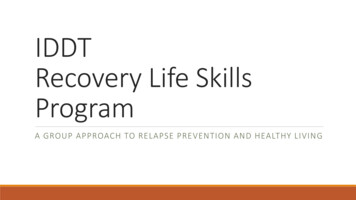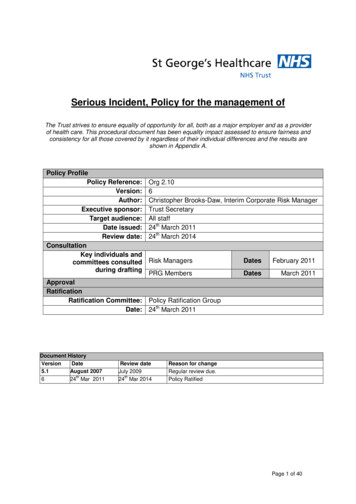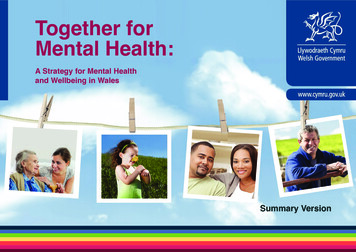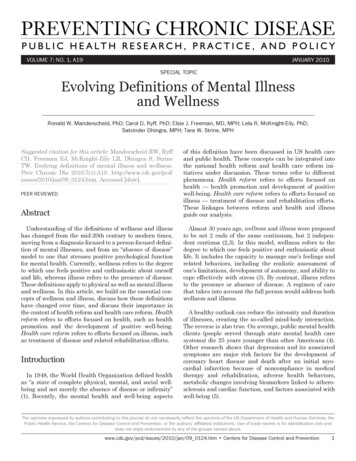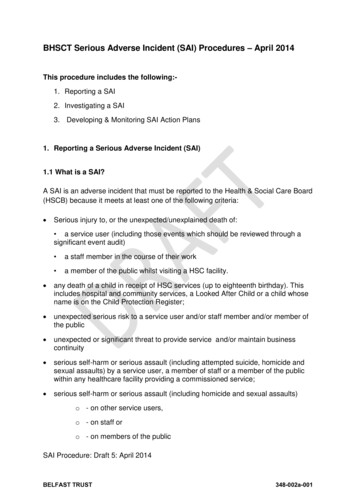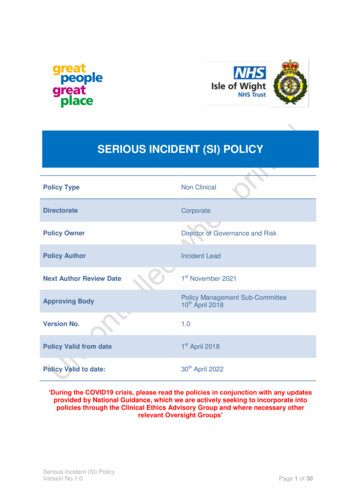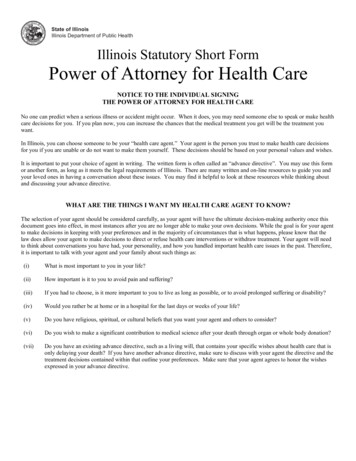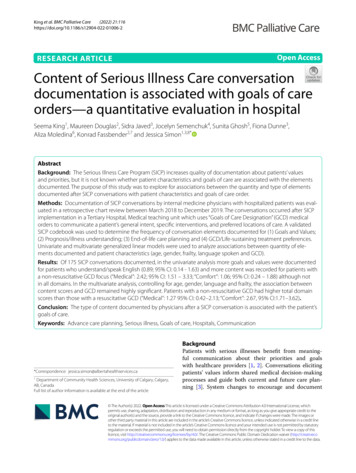
Transcription
(2022) 21:116King et al. BMC Palliative ARCH ARTICLEOpen AccessContent of Serious Illness Care conversationdocumentation is associated with goals of careorders—a quantitative evaluation in hospitalSeema King1, Maureen Douglas2, Sidra Javed3, Jocelyn Semenchuk4, Sunita Ghosh5, Fiona Dunne3,Aliza Moledina6, Konrad Fassbender2,7 and Jessica Simon1,3,8*AbstractBackground: The Serious Illness Care Program (SICP) increases quality of documentation about patients’ valuesand priorities, but it is not known whether patient characteristics and goals of care are associated with the elementsdocumented. The purpose of this study was to explore for associations between the quantity and type of elementsdocumented after SICP conversations with patient characteristics and goals of care order.Methods: Documentation of SICP conversations by internal medicine physicians with hospitalized patients was evaluated in a retrospective chart review between March 2018 to December 2019. The conversations occurred after SICPimplementation in a Tertiary Hospital, Medical teaching unit which uses “Goals of Care Designation” (GCD) medicalorders to communicate a patient’s general intent, specific interventions, and preferred locations of care. A validatedSICP codebook was used to determine the frequency of conversation elements documented for (1) Goals and Values;(2) Prognosis/illness understanding; (3) End-of-life care planning and (4) GCD/Life-sustaining treatment preferences.Univariate and multivariate generalized linear models were used to analyze associations between quantity of elements documented and patient characteristics (age, gender, frailty, language spoken and GCD).Results: Of 175 SICP conversations documented, in the univariate analysis more goals and values were documentedfor patients who understand/speak English (0.89; 95% CI: 0.14 - 1.63) and more content was recorded for patients witha non-resuscitative GCD focus (“Medical”: 2.42; 95% CI: 1.51 – 3.33; “Comfort”: 1.06; 95% CI: 0.24 – 1.88) although notin all domains. In the multivariate analysis, controlling for age, gender, language and frailty, the association betweencontent scores and GCD remained highly significant. Patients with a non-resuscitative GCD had higher total domainscores than those with a resuscitative GCD (“Medical”: 1.27 95% CI: 0.42–2.13; “Comfort”: 2.67, 95% CI:1.71–3.62).Conclusion: The type of content documented by physicians after a SICP conversation is associated with the patient’sgoals of care.Keywords: Advance care planning, Serious illness, Goals of care, Hospitals, Communication*Correspondence: jessica.simon@albertahealthservices.ca1Department of Community Health Sciences, University of Calgary, Calgary,AB, CanadaFull list of author information is available at the end of the articleBackgroundPatients with serious illnesses benefit from meaningful communication about their priorities and goalswith healthcare providers [1, 2]. Conversations elicitingpatients’ values inform shared medical decision-makingprocesses and guide both current and future care planning [3]. System changes to encourage and document The Author(s) 2022. Open Access This article is licensed under a Creative Commons Attribution 4.0 International License, whichpermits use, sharing, adaptation, distribution and reproduction in any medium or format, as long as you give appropriate credit to theoriginal author(s) and the source, provide a link to the Creative Commons licence, and indicate if changes were made. The images orother third party material in this article are included in the article’s Creative Commons licence, unless indicated otherwise in a credit lineto the material. If material is not included in the article’s Creative Commons licence and your intended use is not permitted by statutoryregulation or exceeds the permitted use, you will need to obtain permission directly from the copyright holder. To view a copy of thislicence, visit http:// creat iveco mmons. org/ licen ses/ by/4. 0/. The Creative Commons Public Domain Dedication waiver (http:// creat iveco mmons. org/ publi cdoma in/ zero/1. 0/) applies to the data made available in this article, unless otherwise stated in a credit line to the data.
King et al. BMC Palliative Care(2022) 21:116this communication could help address the alarming discordance between hospitalized patients’ preferences andtheir medical orders [4] and enables sharing of key information between healthcare providers across differentpatient encounters. Conversation documents complement legal documents (such as advance directives) andmedical orders (such as “Do not attempt resuscitation”)and when patient capacity is impaired these documentscan facilitate patient-centered decision-making by surrogates and healthcare providers.The Serious Illness Care Program (SICP) [5] demonstrated that routinizing and improving the quality ofclinician-patient communication enhances patient outcomes, decreasing anxiety and depression [6]. Randomized controlled trials of the SICP in oncology [7] andprimary care [8] also described positive impacts on thequality and frequency of conversation documentation.Similar results were found after the SICP implementationin acute care and internal medicine [9, 10].Many factors can impact the quality and content ofcommunication between patients and providers [11].What is not known, is how the content of documentation might vary with patient characteristics and severityof their illness. Exploring this might highlight areas forquality improvement including clinician training, patientpreparation for conversations or systemic issues or inequities. Therefore, we sought to explore for associationsbetween the quantity and type of elements documentedafter SICP conversations in acute care with patient’s goalsof care orders and the demographic variables such as age,gender, frailty, understanding of English. Even though theintention of the SICP guide is that all questions are asked,and the answers are documented, we hypothesized thatwhat clinicians choose to document may be dependenton patient characteristics. Particularly, we hypothesizeda close association between what is documented andthe patient’s goal of care order that communicates theirpriorities.MethodsDesign and settingThis is a secondary study of documentation of Serious Illness Conversations (SIC) collected in a multi-siteCanadian quality improvement implementation of theSICP in acute care, internal medicine units [12]. Our sitewas a 38-bed Medical Teaching Unit at Foothills Medical Centre, Calgary, Canada. SICP implementation anddata collection occurred March 2018 to December 2019.Thirty internal medicine physicians (15 female) attendedon the unit, with three on service each week. As part ofthe initiative, each physician aimed to conduct and document at least one SIC per week. Physicians used thestructured SIC guide [13] to facilitate discussion of keyPage 2 of 11concepts: patient’s understanding of their health, information preferences and prognosis, goals, fears, strengths,critical abilities, trade-offs they are willing to make forthe possibility of more time and family’s understandingof the patient’s wishes. All components of SICP wereimplemented, including screening to identify appropriate patients, training and cueing clinicians, preparingpatients, and documentation of conversations in the electronic health record (EHR).Patient selectionBased on local data [14] physicians prioritized having SICwith patients 65 years of age or older who were hospitalized for 5 days or more. This identified about 3–5 seriously ill patients per week per attending. A unit champion(charge nurse) screened the unit list weekly and cued thephysicians to consider whether eligible patients wouldbenefit from a SIC. If physicians felt another patient wasa higher priority for a SIC conversation, they were able toselect patients outside the prioritization criteria. Patientswith a previous documented SIC conversation wereexcluded. Patients accepting of conversations were askedwho they would like to be present (e.g., family or friends).Conversation documentationPhysicians were trained to document SIC details in theEHR (Sunrise Clinical Manager) and were reminded todocument by the unit champion. The conversation document was the “Advance Care Planning (ACP) and Goalsof Care Designation (GCD) Tracking Record” (Tracking Record) [15]. It was introduced in 2008 as part of animplementation of a region-wide ACP and GCD policy[16] and procedure [17] as a standard place to record pertinent detailsof conversations and to create a continuousnarrative, as conversations are added over time. A copy ofthe Tracking Record is provided to the patient in a plastic file called the “green sleeve.” This holds and transferstheir other ACP documents, such as their medical order(GCD) [18] and Personal Directive [19] (provinciallylegislated advance directive) across care settings. Ananonymized copy (redacted for patient/staff identifiers)of the Tracking Record was retained for this study.GCDs are a medical order framework [18] that concisely communicate the general focus and indicate thekinds of treatments and locations of care that may bestserve the patient’s goals and preferences. There are threegeneral GCD approaches: a) ‘Resuscitative Care’ to cureor control illnesses using life prolonging interventionsif clinically required (Resuscitative GCD); b) ‘Medical Care’ to cure or control illnesses, but not includingresuscitative or ICU interventions (Medical GCD); and c)‘Comfort Care’ focusing on a palliative approach by managing symptoms and optimizing function to the degree
King et al. BMC Palliative Care(2022) 21:116possible (Comfort GCD).There are subcategories withinthese approaches, with seven possible GCD orders [18].Nuances about a GCD or its interpretation for a givenpatient can be documented in the Tracking Record.Evaluation toolWe evaluated the quantity and comprehensiveness ofdocumentation of conversations in the Tracking Recordusing a standardized SICP codebook [8]. We retained allfour domains from the original codebook: (1) Values orgoals; (2) Prognosis or illness understanding; (3) End-oflife care planning; (4) Life-sustaining treatment preferences. However, we made one significant update to thisrecord by adding a “Strengths” element and deleting the“Quality of Life” element under the “Goals and Values”domain, to reflect the content of the 2017 SIC guide revision. We also adapted the instructions for the coding torecognize GCD orders in the “Life sustaining treatmentpreferences” domain (re-titled “GCD and Life sustaining treatment”) (Supplement 1 adapted SICP Codebook).The total possible score remained 17, with a score of “0”(absent) or “1” (present) for each individual element. Thehigher the total score the more conversation content hasbeen documented.Data extractionAll tracking records completed by physicians duringSICP implementation were randomly distributed amongfour raters (JS, SJ, JRS, MD). Raters were two physicians,the unit champion and a researcher, respectively. Copies of the tracking records were anoymised by redacting Identifying data of patients, family or cliniciansbefore distribution. Using the adapted codebook, ratersindependently abstracted and scored the content of theTracking Record.To minimize interpretation and scoring variation,raters met to train on the codebook and collectively codefive tracking records. Raters met again to discuss issuesor discrepancies after completing coding of 20 trackingrecords. To verify consistency across raters and calculateinter-rater reliability, a subset of 20 randomly selectedtracking records (11%) were coded independently by allraters.Patient demographic data collected as part of the quality improvement study were: age, gender, frailty scores(summarized using the 8-point version of the ClinicalFrailty Score [20]) and ability to understand and speakEnglish as perceived by bedside clinicians (whose conversations were conducted using a language interpretation phone line, or ad hoc family translation, according topatient preference). The latest GCD order in effect on theEHR on the day the conversation occurred was recorded.Page 3 of 11If the GCD changed that day, after the conversation, thatwas the GCD recorded.Statistical analysisThe primary outcome of interest was the total score(max. 17) for each tracking record. The other outcomesof interest were the subdomain scores (Values or goals;Prognosis or illness understanding; End-of-life care planning; Life-sustaining treatment preferences). For thedescriptive statistics, mean and standard deviations werereported for normally distributed continuous variables,median and interquartile ranges were reported for nonnormally distributed continuous variables. Frequencyand proportions were reported for categorical variables.Generalized linear model (GLM) was used to determinethe factors associated with the outcome variables: totalscore, goals, and “values domain” subtotal, “prognosis domain” subtotal, “end-of- life domain” subtotal and“GCD and life sustaining treatment domain” subtotal.Normal distribution was assumed for the outcome variables and link identity was used for the GLM model. Univariate and multivariate GLM models were analyzed foreach outcome variable separately. The factors includedin the univariate and multivariate models were gender(Male vs. Female, there were no non-binary identifying patients), able to speak English for the conversation(yes vs. no), age (35–74 years vs. 75 years, dichotimizedat the median age), frailty category (very fit or well ormanaging well or vulnerable vs. mildly or moderately orseverely or very severely frail) and GCD categories (Medical vs. Resuscitative, Comfort vs. Resuscitative). The finalmodel was all adjusted for age, gender, frailty categoryand ability to speak English as our models adjusted forthe most common confounding factors. The final modelfor all of the outcome variables showed that GCD as anindependent variable, indicating that adjusted and unadjusted GCD variables shows significant association withtotal scores as well as subdomains. All statistical analysis was conducted using SPSS version 25 software [21]. Ap-value 0.05 was used for statistical significance.Intra class correlation tests were conducted to assessthe inter-rater variability. The correlation value betweenraters was 0.726 on single measures, 0.914 on averagemeasures (p value 0.0001, 95% confidence interval,0.914 reliability statistic). The correlation value 0.90 represents excellent agreement between the raters. A valuebetween 0.75 to 0.90 represent good measure of agreement [22].ResultsRecruitmentFigure 1 shows 440 potential patients were identified bythe unit list screening criteria; 78 patients were selected
King et al. BMC Palliative Care(2022) 21:116Page 4 of 11Fig. 1 Strobe diagram of patients recruited for Serious Illness Conversations (SIC) and the number of Tracking Records analyzedby physicians outside those inclusion criteria, and a further 20 patients had a SIC with their physicians but werenot identified through the cueing system (e.g., occurredduring weekends without nurse champion present). Afterall exclusions, refusals and attrition, 180 tracking recordsof SIC were completed by physicians in the electronichealth record and 175 of these were analyzed (5 used incodebook training).Patient characteristicsPatients’ demographic characteristics in Table 1 showsfewer tracking records were from conversations withfemale patients (69 (39.4%) vs. 106 (60.6%)). The meanage of patients was 73.8 years (SD 11.2) and majority(65.1%) of tracking records were for patients rated as vulnerable (category 4) or mildly frail (category 5) on Clinical Frailty Scale, and patients understood/spoke English
King et al. BMC Palliative Care(2022) 21:116Page 5 of 11Table 1 Characteristics of patients who had a Serious IllnessConversation documented on Tracking Record as part of theSerious Illness Conversation Program implementationNo. (%)Characteristicn 175Female69 (39.4)Age32–74 7584 (48.0)91 (52.0)Clinical Frailty ScoreVery Fit (Category 1)3 (1.7)Well (Category 2)10 (5.7)Managing well (Category 3)30 (11.4)Vulnerable (Category 4)52 (29.7)Mildly Frail (Category 5)62 (35.4)Moderately Frail (Category 6)16 (9.1)Severely Frail (Category 7)12 (6.9)Very Severely Frail (Category 8)0 (0)Speak or understand English154 (88)GCDR (resuscitative)51 (29.1)M (medical)76 (43.4)C (comfort)48 (27.4)(88%). Of the three GCD categories, the majority oftracking records were also for those patients that had aMedical GCD (43.4%).Comprehensiveness of conversationsThe median total score of conversation elements documented on the tracking records was 9 (IQR 7- 10, Fig. 2)with the fewest (65.7%) tracking records documentingend-of-life care domain content and most (96.6%) documenting at least one Goal or Value content.AssociationsIn the univariate analysis (Table 2), there was no statistically significant difference between total or domainscores by gender, age, or frailty. More goals and valueswere documented for patients who were able to conductthe conversation in English (0.89; 95% CI: 0.14–1.63).More total content was recorded for patients who had aMedical or Comfort GCD than for Resuscitative GCD(“Medical”: 2.42; 95% CI: 1.51 – 3.33; “Comfort”: 1.06;95% CI: 0.24 – 1.88).In the multivariate analysis, controlling for age, gender,language and frailty, the association between total Tracking Record scores and GCD remained highly significant(Table 3). Specifically, Tracking Records completed forpatients with a Comfort or Medical GCD had highertotal scores (“Comfort”: 2.667; 1.710 – 3.624; “Medical”:1.274; 0.418 – 2.130) than those completed for patientswith a Resuscitative GCD (Fig. 3). Similarly, scores werepositively associated with a Comfort GCD and Medical GCD in the prognosis (“Comfort”: 1.067; 95% CI:0.630–1.503; “Medical”: 0.545; 95% CI: 0.154–0.936) andend-of-life planning (“Comfort”: 2.132; 95% CI: 1.714–2.551; “Medical”: 0.807; 95% CI: 0.433–1.182) domains.Conversely a negative association was found betweenthe Goals and Values domain score and patients with aComfort GCD (-0.687; 95% CI: -1.346—-0.027). For theGCD and life sustaining therapy domain, patients with aMedical GCD had significantly higher scores comparedto reference category Resuscitative GCD (0.327; 95%CI: 0.057–0.598), but not Comfort versus Resuscitative(0.251; 95% CI: -0.051–0.553). In the multivariate modelnone of the other variables were associated with the totalor domain scores with one exception: there was a statistically significant positive association between the score inthe goals and values domain and age 75 years (β 0.586;95% CI: 0.107—1.065).DiscussionThis study is novel in exploring and finding associationsbetween the quantity and type of conversation elementsdocumented by physicians after SIC conversations andthe patient’s GCD (the medical order communicatinga focus on comfort, medical or resuscitative care). Forpatients with a Comfort or Medical GCD, physiciansrecorded more fulsome conversations with higher totalscores and more elements documented in two domains:prognosis, end-of-life planning, than for patients witha Resuscitative GCD. In contrast, physicians were lesslikely to comprehensively document patient’s goals andvalues with patients with a Comfort GCD. It has not beenpreviously reported whether the quality of documentation after SIC is associated with other frameworks likePhysician orders for Life Sustaining Therapy (POLST)[23], or “Do-Not- Attempt-Resuscitation” orders.This association between patient GCD and the totalscores and sub-domain content documented is unsurprising and may be understood by reflecting on clinicalpractice. When a patient is coming closer to end-of-lifeand the goal of care is determined to be on comfort morethan prolonging time, physicians may naturally focusdocumentation on what they perceive to be the most relevant elements and domains, such as discussion abouthospice care (End-of-Life care domain), or prognosticcommunication about worsening of disease (Prognosisor Illness understanding). In contrast when documentingconversations for patients with medical or resuscitativegoals of care, physicians may record more informationabout goals and values because they deem that to bemost relevant to healthcare providers during subsequent
King et al. BMC Palliative Care(2022) 21:116Page 6 of 11Fig. 2 Distribution of documented Serious Illness Conversation element scores (total score and by domain) for Tracking Records. Tracking Recordsfor each patient (n 175) were scored on whether elements from the Serious Illness Conversation Program Codebook [8] were present (1) or absent(0). The Total score (0–17) was comprised of the total score in each domain: Goals and Values (0–7), Prognosis (0–4), End-of-Life Care Planning (0–4),and Goals of Care Designation/Life-sustaining treatments (0–2)treatment decision-making and consent discussions. TheEnd-of-life care domain for patients with Medical orResuscitative GCDs might be less documented becausethese were less frequently elicited with these patients orare deemed less relevant to document within the patient’scurrent priorities or clinical context. We note cliniciansare not specifically trained or prompted to explore ordocument about end-of-life planning using the SIC guidealthough this is a domain in the codebook. Nonetheless,physicians documented about the end-of-life planningdomain in 66% of conversations. It is somewhat worrying, that patients with resuscitative goals had less totalcontent documented. This could represent a physicianbias towards less fulsome conversations or documentation about the use of life sustaining therapies with thesepatients.
0.20 (-0.56; 0.95)4.00-0.04 (-0.54; 0.46)English understood and spoken by patient Vs. English not understood and spoken by patientp 0.05; Ref Reference category-0.45 (-1.03; 0.12)-0.82 (-1.45; -0.18)*RefRef0.89 (0.14; 1.63)*Ref0.47 (-0.01; 0.96)Ref*3.504.004.003.004.003.004.004.00-0.42 (-0.91; 0.06)RefClinical Frailty score 1–3 (not frail) Vs. 4–8 (Frail)l1.06 (0.24; 1.88)*2.42 (1.51; 3.33)*RefRef0.35 (-0.79; 1.48)Ref-0.12 (-0.86; 0.62)Ref4.004.00b10.00Comfort-0.52 (-1.26; glishNon-EnglishLanguageb8.009.00Not FrailFrailFrailtya9.008.00MaleFemaleGender8.009.00 75 years 75 yearsAgeEstimate(95% CI)MedianMedianEstimate(95% CI)Goals and ValuesTotal MedianPrognosis0.47 (0.10; 0.84)*1.02 (0.61; 1.44)*RefRef-0.15 (-0.67; 0.36)Ref-0.24 (-0.57; 0.09)Ref0.15 (-0.19; 0.49)Ref0.15 (-0.19; 0.48)Estimate(95% ianEnd of Life0.74 (0.38; 1.10)*2.00 (1.60; 2.40)*RefRef-0.31 (-0.88; 0.27)Ref-0.18 (-0.55; 0.20)Ref-0.05 (-0.43; 0.34)Ref-0.07 (-0.45; 0.30)Estimate (95% ian0.30 (0.05;0.56)*0.28 (-0.01;0.56)RefRef-0.05 (-0.39; 0.28)Ref-0.12 (-0.34; 0.10Ref0.09 (-0.14; 0.31)Ref-0.14 (-0.36; 0.08)Estimate (95% CI)GCD and Life sustainingtreatmentTable 2 Univariate analysis of patient characteristics (age, gender, Clinical Frailty Score, ability to understand/speak English and Goals of Care Designation (GCD)) and SeriousIllness Conversation documentation element scores according to Serious Illness Conversation Program CodebookKing et al. BMC Palliative Care(2022) 21:116Page 7 of 11
King et al. BMC Palliative Care(2022) 21:116Page 8 of 11Table 3 Results of the generalized linear model (adjusted for age, gender, frailty, speaking English language) showing the associationbetween Goals of Care Designation (GCD) and Tracking Record total and individual domain scoresBStd ErrorLower CIUpper CIWald Chi-SquaredP -valueTotal Score Ca Vs. Rb2.6670.4881.7103.624 Mc Vs. R1.2740.4370.4182.13029.85 0.0018.5060.004Goals and values domainC Vs. R-0.6870.3365-1.346-0.0274.1670.041M Vs. R-0.3990.3012-0.9900.1911.7580.185Prognosis domainC Vs. R1.0670.2230.6301.50322.950 0.001M Vs. R0.5450.1990.1540.9367.4760.006End-of-life DomainC Vs. R2.1320.2131.7142.55199.915 0.001M Vs. R0.8070.1900.4331.18217.880 0.001GCD and life-sustaining therapy domainaC Vs. R0.2510.154-0.0510.5532.6520.103M Vs. R0.3270.1380.0570.5985.6340.018Comfort, bResuscitative, cMedicalThere is also an ongoing concern about equity andinclusion in advance care planning [24]. We found gender, age and frailty were not associated with differencesin documentation content, however fewer patients’ goalsand values were documented for patients who wereunable to conduct the conversation in English. Only 21such patients were included in the study and of note ninepatients who met inclusion criteria were not selectedby physicians for conversations because of “language/communication barriers.” Although there are multiplelanguage SIC translations, its use requires the medicalinterpreter to have direct access to the appropriate version. Our centre’s lack of in-person interpretation maylimit a physician’s ability to directly elicit patients’ ownvalues, as these are conveyed through a phone-basedlanguage translation line or a family member. It is notknown what was ‘lost in translation’ or what physicianor family biases were factors in what was discussed ordocumented. Indeed, patient selection for conversationswas up to the discretion of the physician and thereforeopen to potential physician selection biases includinggender and language ability. The reasons behind thesedifferences, and exploring other intersecting equity factors such as ethnicity, socioeconomic status are startingpoints for further research.A study strength included using the standardizedcodebook, to allow comparison with other SICP studies. Our median score of 9 conversation elementsrecorded on the tracking record was identical to themedian score for conversations documented using atemplated letter format at another acute care site [10].Other studies [8–10] have not reported the inter-rateragreement when applying the codebook and this is ofconcern because although there was high agreementfor average rating scores, inter-rater agreement on single measures was only moderate.In addition to the major limitation of selection biasin who was selected or excluded for a SIC conversation,another limitation is that we did not analyze who waspresent for the SIC conversations (e.g., family, friends,substitute decision makers) or how language translation was provided. It was also difficult to collect howmany GCDs may have changed because of the SIC conversation, as GCD changes can occur as part of a process of conversations and reflection happening overa few days or weeks. We are also unable to assess thegap between what was actually discussed and what wassubsequently documented in health records. There mayalso be a physician bias towards documenting conversation elements that support or align with the patient’sexisiting GCD or the GCD determined through the SICconverstion. Geerse et al. [25] compared cancer outpatient audiotaped SIC conversations and documentationand found that 36% of conversational information wasnot documented; with function, fears and worries andtradeoffs most often discussed but not documented.They found high (87%) adherence with asking aboutSIC guide components but only 43% of all conversation elements were deemed fully concordant with theirdocumentation.
King et al. BMC Palliative Care(2022) 21:116Page 9 of 11Fig. 3 Percentage of Tracking Records recording Serious Illness Conversation element scores (total score and by domain) by patient’s Goals ofCare Designation. Total and domain scores of elements from the Serious Illness Conversation Program Codebook [8] for Tracking Records (n 175).Elements were coded as 1 if present and 0 if absent. The Total score (0–17) was comprised of the total score in each domain: Goals and Values(0–7), Prognosis (0–4), End-of-Life Care Planning (0–4), and Goals of Care Designation/Life-sustaining treatments (0–2). Distributions shown, are bypatient’s Goals of Care Designation (GCD) which are a) ‘Resuscitative Care’ (R); b) ‘Medical Care’ (M); and c) ‘Comfort Care’ (C)
King et al. BMC Palliative Care(2022) 21:116ConclusionThis study is the first to demonstrate that the quantityand type of conversation domains documented by physicians after a SIC conversation varies with the medical orders describing the patient’s goals of care. Howthis varied documentation impacts subsequent clinicalpractice is a focus for our future studies. Other factors like age, gender, frailty, were not as significantlyassociated with the quality of conversation documentation but the findings point towards a need to attendto language barriers in eliciting patients own goals andvalues. The practice implications are that clininiciansconducting and documenting SIC conversations shouldbe aware of potential personal and systemic biaseswhen eliciting patients’ priorties and actively listen andaccurately document what is expressed.AbbreviationsSICP: Serious Illness Care Program; SIC: Serious Illness Conversations; EHR:Electronic health record; ACP: Advance Care Planning; GCD: Goals of CareDesignation; Resuscitative GCD: Resuscitative Care Goals of Care Designation;Medical GCD: Medical Care Goals of Care Designation; Comfort GCD: ComfortCare Goals of Care Designation; GLM: Generalized Linear Model.Supplementary InformationThe online version contains supplementary material available at https:// doi. org/ 10. 1186/ s12904- 022- 01006-2.Additional file 1: Supplement 1. Revised Codebook rules for codingserious illness conversations on the tracking record.AcknowledgementsNot applicable.Authors’ contributionsSK:prepared manuscript, analyzed and interpreted the data. MD: data acquisition, analyzed and interpreted the data. SJ: analyzed and interpreted the data.JS: data acquisition, analyz
patients with a Comfort or Medical GCD had higher total scores ("Comfort": 2.667; 1.710 - 3.624; "Medical": 1.274; 0.418 - 2.130) than those completed for patients with a Resuscitative GCD (Fig. 3). Similarly, scores were positively associated with a Comfort GCD and Medi-cal GCD in the prognosis ("Comfort": 1.067; 95% CI:
